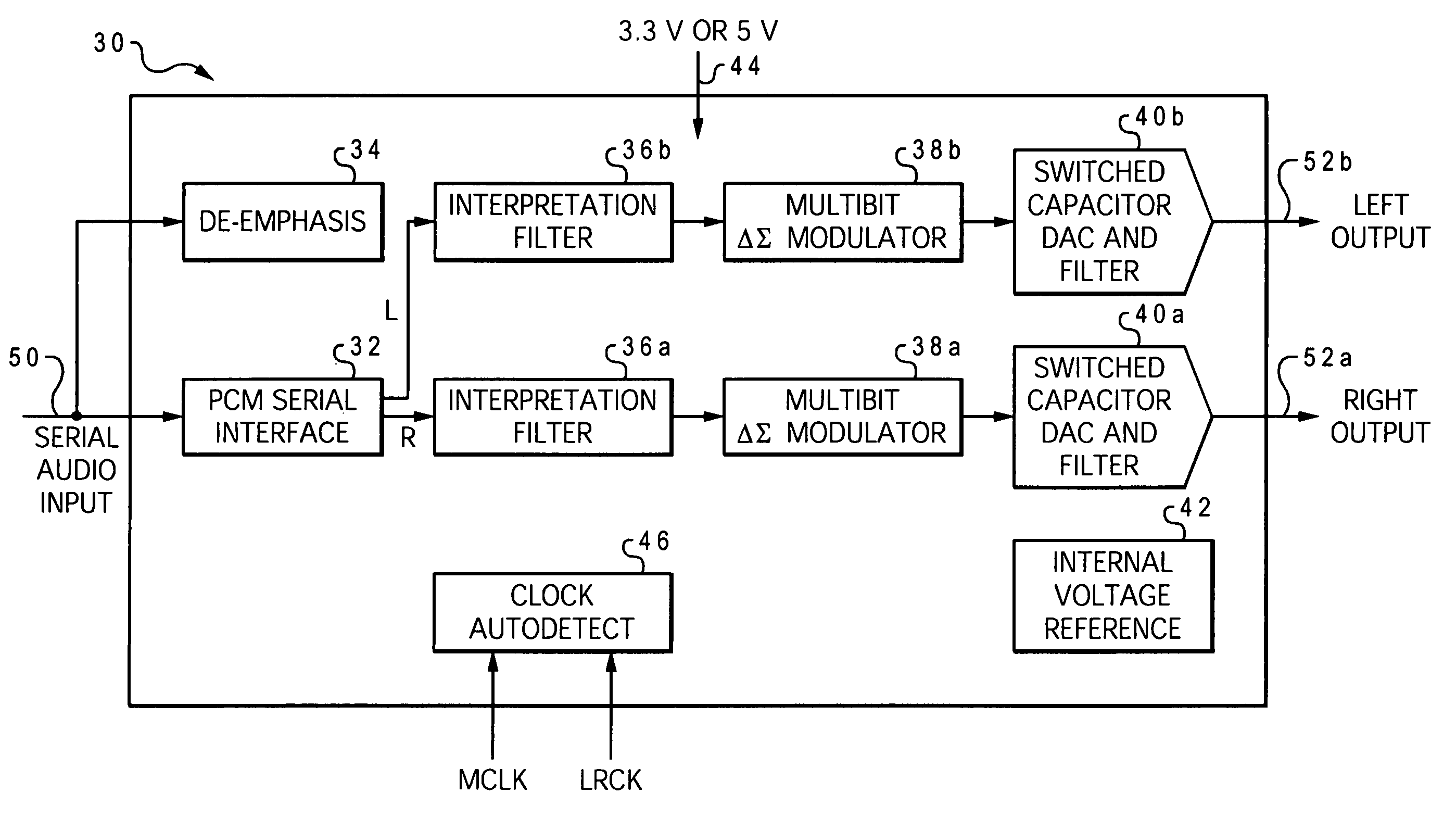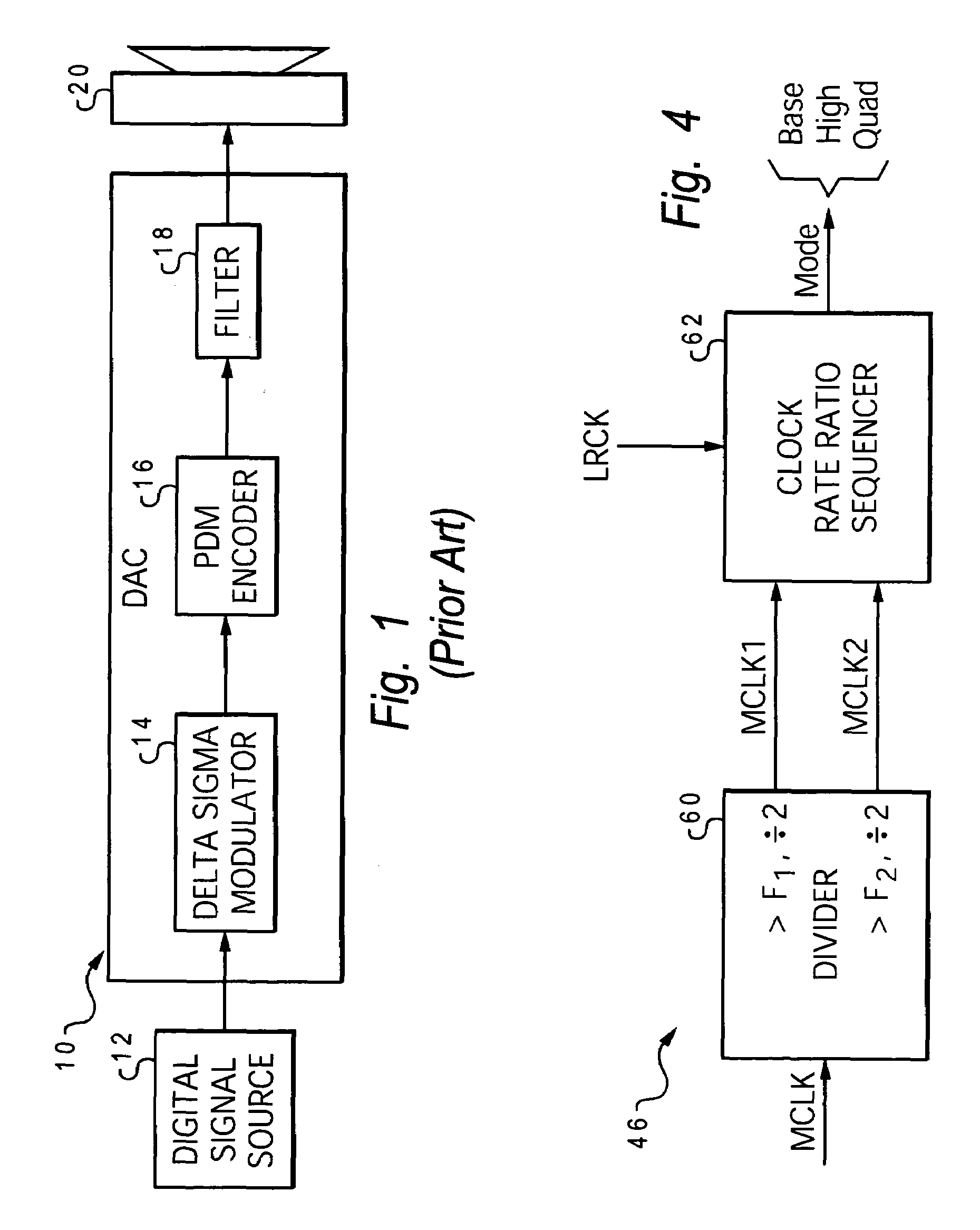Scheme for determining internal mode using MCLK frequency autodetect
a technology of autodetect and internal mode, applied in the direction of digital-analog converters, instruments, digital recording/recording, etc., can solve the problems of increasing complexity and capability of conventional data converters, requiring precise timing, and requiring precise timing, so as to achieve the effect of not adding excessive overhead
- Summary
- Abstract
- Description
- Claims
- Application Information
AI Technical Summary
Benefits of technology
Problems solved by technology
Method used
Image
Examples
example 1
[0053]MCLK is 18 MHz, LRCK is 48 kHz, and it is assumed that the first trip frequency is close to (or below) its nominal rate of 16 MHz. MCLK will accordingly trip F1 but not trip F2. Therefore:
[0054]MCLK1=9 MHz
[0055]MCLK2=18 MHz
[0056]ratio for first mux input=9 MHz / 48 kHz=192
[0057]ratio for second mux input=12 MHz / 48 kHz=256
[0058]ratio for third mux input=4.5 MHz / 48 kHz=96
[0059]ratio for fourth mux input=8 MHz / 48 kHz=167
Result: 256 is identified as a valid ratio during the first check cycle, and the base mode of operation is enabled.
example 2
[0060]Similar to Example 1, MCLK is 18 MHz and LRCK is 48 kHz, but it is now assumed that the first trip frequency is greatly above its nominal rate (i.e., it is above 18 MHz). MCLK will accordingly not trip either F1 or F2. Therefore:
[0061]MCLK1=18 MHz
[0062]MCLK2=18 MHz
[0063]ratio for first mux input=18 MHz / 48 kHz=384
[0064]ratio for second mux input=12 MHz / 48 kHz=256
[0065]ratio for third mux input=9 MHz / 48 kHz=192
[0066]ratio for fourth mux input=8 MHz / 48 kHz=167
Result: 256 is still identified as a valid ratio during the first check cycle, and the base mode of operation is enabled.
example 3
[0067]MCLK is 18 MHz, LRCK is 192 kHz, and it is again assumed that the first trip frequency is close to (or below) its nominal rate of 16 MHz. MCLK will accordingly trip F1 but not trip F2. Therefore:
[0068]MCLK1=9 MHz
[0069]MCLK2=18 MHz
[0070]ratio for first mux input=9 MHz / 192 kHz=48
[0071]ratio for second mux input=12 MHz / 192 kHz=64
[0072]ratio for third mux input=4.5 MHz / 192 kHz=24
[0073]ratio for fourth mux input=8 MHz / 192 kHz=43
Result: 64 is identified as a valid ratio during the third check cycle, and the quad mode of operation is enabled.
[0074]The clock autodetect feature of the present invention may be further understood with reference to the flow chart of FIG. 7. The process starts at power up block 90. The autodetect unit waits until both an MCLK and an LRCK are detected at block 92. The MCLK rate is then compared to the first trip frequency at decision block 94. If MCLK is less than or equal to F1, then MCLK1 is set to MCLK at block 96, but if MCLK is greater than F1, then MC...
PUM
 Login to View More
Login to View More Abstract
Description
Claims
Application Information
 Login to View More
Login to View More - R&D
- Intellectual Property
- Life Sciences
- Materials
- Tech Scout
- Unparalleled Data Quality
- Higher Quality Content
- 60% Fewer Hallucinations
Browse by: Latest US Patents, China's latest patents, Technical Efficacy Thesaurus, Application Domain, Technology Topic, Popular Technical Reports.
© 2025 PatSnap. All rights reserved.Legal|Privacy policy|Modern Slavery Act Transparency Statement|Sitemap|About US| Contact US: help@patsnap.com



